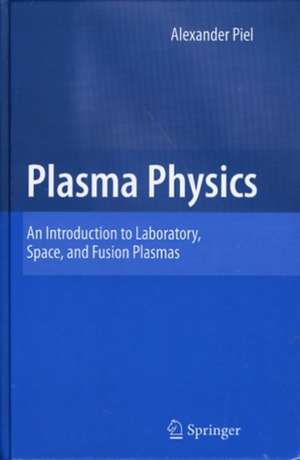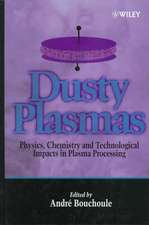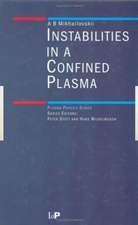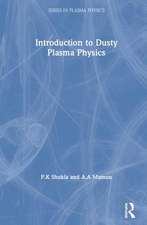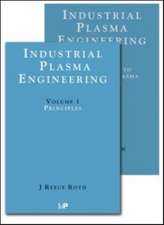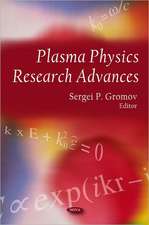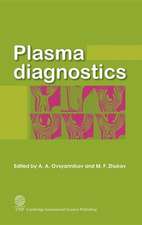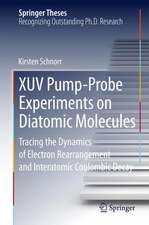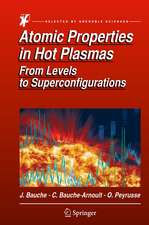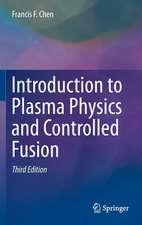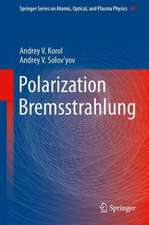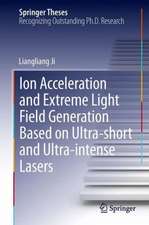Plasma Physics: An Introduction to Laboratory, Space, and Fusion Plasmas
Autor Alexander Pielen Limba Engleză Hardback – 27 iun 2010
| Toate formatele și edițiile | Preț | Express |
|---|---|---|
| Paperback (2) | 448.72 lei 6-8 săpt. | |
| Springer Berlin, Heidelberg – 14 noi 2014 | 448.72 lei 6-8 săpt. | |
| Springer International Publishing – 18 mai 2018 | 536.63 lei 6-8 săpt. | |
| Hardback (2) | 447.00 lei 38-44 zile | |
| Springer – 27 iun 2010 | 447.00 lei 38-44 zile | |
| Springer International Publishing – 18 sep 2017 | 712.36 lei 6-8 săpt. |
Preț: 447.00 lei
Nou
Puncte Express: 671
Preț estimativ în valută:
85.54€ • 88.37$ • 71.19£
85.54€ • 88.37$ • 71.19£
Carte tipărită la comandă
Livrare economică 21-27 martie
Preluare comenzi: 021 569.72.76
Specificații
ISBN-13: 9783642104909
ISBN-10: 3642104908
Pagini: 416
Ilustrații: 180 schwarz-weiße Abbildungen
Dimensiuni: 155 x 235 x 28 mm
Greutate: 0.7 kg
Ediția:2010
Editura: Springer
Colecția Springer
Locul publicării:Berlin, Heidelberg, Germany
ISBN-10: 3642104908
Pagini: 416
Ilustrații: 180 schwarz-weiße Abbildungen
Dimensiuni: 155 x 235 x 28 mm
Greutate: 0.7 kg
Ediția:2010
Editura: Springer
Colecția Springer
Locul publicării:Berlin, Heidelberg, Germany
Public țintă
GraduateDescriere
This book is an outgrowth of courses in plasma physics which I have taught at Kiel University for many years. During this time I have tried to convince my students that plasmas as different as gas dicharges, fusion plasmas and space plasmas can be described in a uni ed way by simple models. The challenge in teaching plasma physics is its apparent complexity. The wealth of plasma phenomena found in so diverse elds makes it quite different from atomic physics, where atomic structure, spectral lines and chemical binding can all be derived from a single equation—the Schrödinger equation. I positively accept the variety of plasmas and refrain from subdividing plasma physics into the traditional, but arti cially separated elds, of hot, cold and space plasmas. This is why I like to confront my students, and the readers of this book, with examples from so many elds. By this approach, I believe, they will be able to become discoverers who can see the commonality between a falling apple and planetary motion. As an experimentalist, I am convinced that plasma physics can be best understood from a bottom-up approach with many illustrating examples that give the students con dence in their understanding of plasma processes. The theoretical framework of plasma physics can then be introduced in several steps of re nement. In the end, the student (or reader) will see that there is something like the Schrödinger equation, namely the Vlasov-Maxwell model of plasmas, from which nearly all phenomena in collisionless plasmas can be derived.
Cuprins
Definition of the Plasma State.- Single Particle Motion in Electric and Magnetic Fields.- Stochastic Processes in a Plasma.- Fluid Models.- Plasma Waves.- Plasma Boundaries.- Instabilities.- Kinetic Description of Plasmas.- Dusty Plasmas.- Plasma Generation.
Recenzii
From the reviews:
“Plasma Physics offers a broad and modern introduction to the many aspects of plasma science … . A curious student or interested researcher could track down laboratory notes, older monographs, and obscure papers … . with an extensive list of more than 300 references and, in particular, its excellent overview of the various techniques to generate plasma in a laboratory, Plasma Physics is an excellent entree for students into this rapidly growing field. It’s also a useful reference for professional low-temperature plasma researchers.” (Michael Brown, Physics Today, June, 2011)
“Plasma Physics offers a broad and modern introduction to the many aspects of plasma science … . A curious student or interested researcher could track down laboratory notes, older monographs, and obscure papers … . with an extensive list of more than 300 references and, in particular, its excellent overview of the various techniques to generate plasma in a laboratory, Plasma Physics is an excellent entree for students into this rapidly growing field. It’s also a useful reference for professional low-temperature plasma researchers.” (Michael Brown, Physics Today, June, 2011)
Textul de pe ultima copertă
Plasma Physics gives a comprehensive introduction to the basic processes in plasmas and demonstrates that the same fundamental concepts describe cold gas-discharge plasmas, space plasmas, and hot fusion plasmas. Starting from particle drifts in magnetic fields, the principles of magnetic confinement fusion are explained and compared with laser fusion. Collective processes are discussed in terms of plasma waves and instabilities. The concepts of plasma description by magnetohydrodynamics, kinetic theory, and particle simulation are stepwise introduced. Space charge effects in sheath regions, double layers and plasma diodes are given the necessary attention. The new fundamental mechanisms of dusty plasmas are explored and integrated into the framework of conventional plasmas. The book concludes with a brief introduction to plasma discharges.
Written by an internationally renowned researcher in experimental plasma physics, the text keeps the mathematical apparatus simple and emphasizes the underlying concepts. The guidelines of plasma physics are illustrated by a host of practical examples including plasma diagnostics with different Langmuir probe methods or laser interferometry, ionospheric sounding, Faraday rotation, space thrusters, and diagnostics of dusty plasmas. Though primarily addressing students in plasma physics, the book is easily accessible for researchers in neighboring disciplines, such as space science, astrophysics, material science, applied physics, and electrical engineering.
The text is based on an introductory course to plasma physics and more specialized courses in plasma diagnostics, dusty plasmas, and plasma waves, which the author has taught at Kiel University for two decades. The pedagogical approach combines detailed explanations, a large number of illustrative figures, short summaries of the basics at the end of each chapter, and a selection of problems with detailed solutions. The book is primarily aimed at students meeting plasma physics for the first time after taking an advanced undergraduate course in electricity and magnetism. The book is structured to serve as a text for a two-semester introductory course in plasma physics at the advanced undergraduate or early graduate level. Some more advanced topics will help bridging the gap to plasma theory. In view of its practical advice in plasma discharges and diagnostics, Plasma Physics will become a useful resource on the bookshelf of PhD students and researchers.
Written by an internationally renowned researcher in experimental plasma physics, the text keeps the mathematical apparatus simple and emphasizes the underlying concepts. The guidelines of plasma physics are illustrated by a host of practical examples including plasma diagnostics with different Langmuir probe methods or laser interferometry, ionospheric sounding, Faraday rotation, space thrusters, and diagnostics of dusty plasmas. Though primarily addressing students in plasma physics, the book is easily accessible for researchers in neighboring disciplines, such as space science, astrophysics, material science, applied physics, and electrical engineering.
The text is based on an introductory course to plasma physics and more specialized courses in plasma diagnostics, dusty plasmas, and plasma waves, which the author has taught at Kiel University for two decades. The pedagogical approach combines detailed explanations, a large number of illustrative figures, short summaries of the basics at the end of each chapter, and a selection of problems with detailed solutions. The book is primarily aimed at students meeting plasma physics for the first time after taking an advanced undergraduate course in electricity and magnetism. The book is structured to serve as a text for a two-semester introductory course in plasma physics at the advanced undergraduate or early graduate level. Some more advanced topics will help bridging the gap to plasma theory. In view of its practical advice in plasma discharges and diagnostics, Plasma Physics will become a useful resource on the bookshelf of PhD students and researchers.
Caracteristici
Different from most introductory texts, modern fields of plasma physics, such as low-temperature plasmas, plasma discharges and plasma diagnostics are covered
Emphasis on experimental point of view and laboratory applications
Gives introduction to forefront research on complex plasmas, like non-neutral or dusty plasmas
Emphasis on experimental point of view and laboratory applications
Gives introduction to forefront research on complex plasmas, like non-neutral or dusty plasmas
Notă biografică
Prof. Dr. Alexander Piel obtained his PhD in plasma physics from Ruhr-Universität Bochum in 1977 and habilitated in 1986. Since 1989 he is full professor of atomic and plasma physics at Kiel University. The author is a fellow of the American Physical Society and served as chair of the plasma physics division of Deutsche Physikalische Gesellschaft (German Physical Society). He has published more than 200 peer-reviewed articles in international journals and several book chapters.
